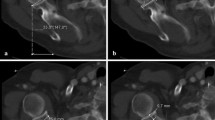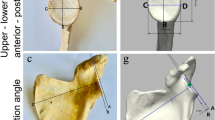Abstract
Purpose
Total shoulder arthroplasty planning requires a preoperative assessment of the glenoid version. This study aimed to determine the morphologic profile of the glenoid cavity and our null hypothesis was that age may affect the spiraling aspect.
Method
114 CT arthrographies of patients from 15 to 78 years old were included. Four groups were defined according to age: 15–29, 30–44, 45–59 years old, and over 60. The version of the glenoid was measured in the axial plane according to the most common method: a line is drawn between the osseous anterior and posterior margins of the glenoid and the version corresponds to the angle between this line and the transverse axis of the glenoid. The transverse axis of the scapula is determined by a line drawn from the center of the glenoid fossa to the medial border of the scapula. The axial plane (perpendicular to the supero-inferior axis of the glenoid cavity) was defined by multiplanar reconstruction. The measurements were performed at three regions of interest: the level of the coracoid process (region A), the level of the notch on the anterior border of the glenoid (region B), and the region of the greater antero-posterior diameter (region C).
Results
96 % of the glenoid cavities included were retroverted. The mean version in region A was 11.9° (0–24.3, S-D 5.2), in region B 6.85° (−5.2 to 12.1, S-D 4.13) and in region C 4.04° (−7.7 to 11.1, S-D 4.04). The difference between the mean version of region A and region B was 5.02° and the difference between the mean version of the region B and the mean version of the region C was 2.81°. When considering the rate of change of the mean version between two adjacent regions, no difference was observed between the four groups of age.
Discussion
The analysis showed the importance of the axial reconstruction plan chosen to allow interpretable and reproducible measures. A decreasing version of the glenoid superior-to-inferior was observed, presenting a spiraling twist as described in previous studies. The profile of variation does not change in the four groups of patients included. The reconstruction of an articular surface as close to the anatomy as possible would also participate in establishing the muscular balance and the constraints on implants. Up to now, implants do not take into account this cranio-caudal twisting.




Similar content being viewed by others
References
Bryce CD, Davison AC, Lewis GS, Wang L, Flemming DJ, Armstrong AD (2010) Two dimensional glenoid version measurements vary with coronal and sagittal scapular rotation. J Bone Joint Surg Am 90:692–699
Budge MD, Lewis GS, Schaefer E, Coquia S, Flemming DJ, Armstrong AD (2011) Comparison of standard two-dimensional and three-dimensional corrected glenoid version measurement. J Should Elbow Surg 20:577–583
Rockwood CA Jr (2009) The shoulder, 4th edn. Elsevier, Philadelphia
Clavert P, Millett PJ, Warner JJ (2007) Glenoid resurfacing: what are the limits to asymmetric reaming for posterior erosion? J Should Elbow Surg 16:843–848
Couteau B, Mansat P, Darmana R, Mansat M, Egan J (2000) Morphological and mechanical analysis of the glenoid by 3D geometric reconstruction using computed tomography. Clin Biomech (Bristol, Avon) 15 Suppl 1:S8–S12
De Wilde L, Verstraeten T, Speeckaert W, Karelse A (2010) Reliability of the glenoid plane. J Should Elbow Surg 19:414–422
De Wilde L, Defoort S, Verstraeten TR et al (2012) A 3D-CT scan study of the humeral and the glenoid planes in 150 normal shoulders. Surg Radiol Anat 34(8):743–750
Farng E, Zingmond D, Krenek L, Soohoo NF (2011) Factors predicting complication rates after primary shoulder arthroplasty. J Should Elbow Surg 20:557–563
Friedman RJ, Hawthorne KB, Genez BM (1992) The use of computerized tomography in the measurement of glenoid version. J Bone Joint Surg Am 74:1032–1037
Hoenecke HR Jr, Hermida JC, Flores-Hernandez C, D’Lima DD (2010) Accuracy of CT-based measurement of glenoid version for total shoulder arthroplasty. J Should Elbow Surg 19:166–191
Iannotti JP, Greeson C, Downing D, Sabesan V, Bryan JA (2012) Effect of glenoid deformity on glenoid component placement in primary shoulder arthroplasty. J Should Elbow Surg 21:48–55
Inui H, Sugamoto K, Miyamoto T, Machida A, Hashimoto J, Nobuhara K (2001) Evaluation of three-dimensional glenoid structure using MRI. J Anat 199:23–28
Jeske HC, Oberthaler M, Klingensmith M et al (2009) Normal glenoid rim anatomy and the reliability of shoulder instability measurements based on intrasite correlation. Surg Radiol Anat 31(8):623–625
Kraljevic M, Zumstein V, Hugli R et al (2013) A comparison of subchondral bone mineralization between the glenoid cavity and the humeral head on 57 cadaverous shoulder joints. Surg Radiol Anat 35(4):295–300
Lewis GS, Armstrong AD (2011) Glenoid spherical orientation and version. J Should Elbow Surg 20:3–11
Monk AP, Berry E, Limb D, Soames RW (2001) Laser analysis of the glenoid fossa of the scapula. Clin Anat 14:320–323
Rouleau DM, Kidder JF, Pons-Villanueva J, Dynamidis S, Defranco M, Walch G (2010) Glenoid version: how to measure it? Validity of different methods in two-dimensional computed tomography scans. J Should Elbow Surg 19:1230–1237
Shapiro TA, Mc Garry MH, Gupta R, Lee YS, Lee TP (2007) Biomechanical effects of glenoid retroversion in total shoulder arthroplasty. J Should Elbow Surg 16(3 Suppl):90–95
Schlemmer B, Dosch JC, Gicquel P, Boutemy P, Wolfram R, Kempf JF (2002) Analyze tomodensitométrique de la rétrotorsion humérale et de la retroversion glénoïdienne. Rev Chir Orthop Reparatrice Appar Mot 88:553–560
Soslowsky LJ, Flatow EL, Bigliani LU, Pawluk RJ, Ateshian GA, Mow VC (1992) Quantitation of in situ contact areas at the glenohumeral joint: a biomechanical study. J Orthop Res 10:524–534
Sugamoto K, Miyamoto T, Machida A, Hashimoto J, Nobuhara K (2001) Evaluation of the three-dimensional glenoid structure using MRI. J Anat 199:323–328
Walch G, Badet R, Boulahia A, Khoury A (1999) Morphologic study of the glenoid in primary glenohumeral osteoarthritis. J Arthroplasty 14:756–760
Conflict of interest
The authors declare that they have no conflicts of interest concerning this article.
Author information
Authors and Affiliations
Corresponding author
Rights and permissions
About this article
Cite this article
Bouchaib, J., Clavert, P., Kempf, JF. et al. Morphological analysis of the glenoid version in the axial plane according to age. Surg Radiol Anat 36, 579–585 (2014). https://doi.org/10.1007/s00276-013-1238-6
Received:
Accepted:
Published:
Issue Date:
DOI: https://doi.org/10.1007/s00276-013-1238-6




